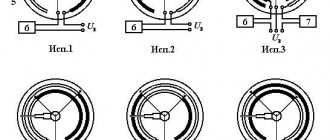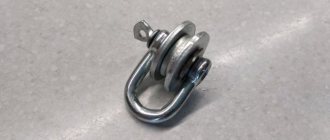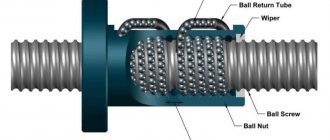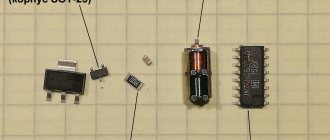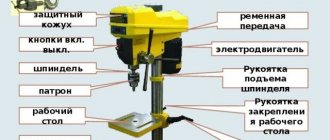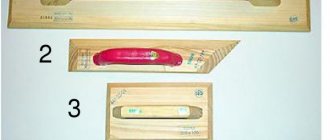Device and main components
A hand scythe consists of: a knife, a scythe, a handle, a wedge and a ring.
Did you know?
The knife can make a sound reminiscent of a bell.
The blade is a long blade curved towards the bottom.
Made of tool steel (U8, U7). There is a classification depending on the length of the knife: 50 cm - 5, 60 cm - 6 cm and up to 9. The most common is No. 5. Consists of: blade, butt, tip, spout, heel and beard.
You can distinguish a high-quality blade from a scythe by the following characteristics:
- no damage or irregularities;
- equal blade thickness;
- deep sound upon impact;
- good elasticity.
Knives also have another name - Lithuanian or canvas.
Often gardeners and gardeners have to struggle with. There is a lot for mechanical removal of enemies of cultivated plants. Among them - . A flat cutter can be used to cut and pull out. Note that it is quite possible to make this manual cultivator yourself.
The braid, or scythe, handle, is the long wooden base of a hand-held scythe. Length - 1.7 or 2 m. Must be without damage, elastic, even. A good material is a spruce trunk at a height of 2 m. For production: remove unnecessary elements (knots, bark), give the desired shape, dry in a vertical position, sand, or soak in a wax solution.
To start making a hand-held grass scythe, you need to know how to fit the scythe onto the scythe: make an angled cut at the end and a small indentation for the tenon of the heel of the blade. For mowing on uneven terrain, the cut is 35 mm, on flat terrain – 10 mm.
For more convenient mowing, there is a handle or bow. For fastening: cut a square into the braid, hammer in the spike of the handle, wedge it, you can strengthen it with self-tapping screws or self-tapping screws.
There are motionless
and
adjustable
. The first ones are stable and reliable, the second ones are more convenient if used by many people.
A wedge is a wooden device for attaching a blade to a braid. Made from dry wood
It is important that the fastening is reliable, because integrity and safety depend on it. Rings are the second element of fastening the knife to the handle in the form of a bolt fastening
Used together with a wedge. There are narrow and wide, with and without a key. Rings with adjustable bolts are called "clamps"
The rings are the second element for attaching the knife to the handle in the form of a bolt fastening. Used together with a wedge.
There are narrow and wide, with and without a key. Rings with adjustable bolts are called “clamps.”
Twine is a special type of strong thread. Required for adjustable handle. When bending, it or wire is used to tie the two ends of a beam made of a flexible type of wood and secure it using notches cut into them.
How to sharpen knives
vottak.net Before proceeding to the sharpening process, immerse the whetstone in oil or water for 15 minutes.
This will extend the life of the bar, since steel particles will not get clogged between the grains. You should start sharpening with a coarse-grained stone
It is important to correctly position the blade relative to the surface of the block, since the final result largely depends on this. The correct sharpening angle is also important: experts advise sharpening the blade at an angle of 20 degrees, but this may vary depending on the type of knife
- Professional chef's and fillet knives require an angle of 25 degrees.
- Japanese kitchen knives should be sharpened at an angle of 10–20 degrees.
- For hunting blades, an angle of 30 to 45 degrees is used. A larger angle is required for greater resistance to dulling.
- For household kitchen knives, an angle of 30 degrees is sufficient.
The rule here is simple: if you want to make the knife sharper, we reduce the sharpening angle, and for greater resistance to dulling, we increase it.
You need to sharpen with continuous movements, lifting the handle at the moment when the block reaches the bend of the blade. This will maintain the sharpening angle of the cutting edge.
It is important that the movement of the blade is perpendicular to the edge, while applying slight pressure to the blade
Grinding
lastday.club When the main sharpening has been completed, we begin grinding. For this you will need a fine-grained stone. Grinding is necessary to level the surface and remove burrs. The technology remains unchanged.
What does a sickle consist of?
This tool consists of a curved knife with a handle (Fig. 1), but the shape of the cutting part is determined by the need to ensure equal force at any point on the blade that occurs during cutting.
Fig.1. Sickle: 1 - sickle knife;
2 - handle In turn, the constancy of forces at any point of the cutting edge is ensured by the constancy of the angle, and at any point of the knife blade (angle a - the angle between a straight line drawn from point O, located on the axis of symmetry of the handle, to any point of the knife blade , and the tangent at this point to the curve of the blade).
Long-term practice of using sickles has shown that the angle a=51° is optimal. A notch 0.4 mm deep is made on the cutting edge of the blade (Fig. 2), as a result of which the knife blade consists of teeth. The notch is made either perpendicular to the edge of the blade (type 1), or at an acute angle to it (type 2).
Fig.2 .
Varieties of the cutting edge of the sickle: 1 - blade of the knife; 2 - chamfer; 3 - teeth The most widespread are sickles with notches of type 2.
Classification
Such a long period of development of the instrument could not but affect its appearance and structure. Modern sickles can be classified according to a number of characteristics.
By type of handle
According to the sales results, sickles with a handle 11 cm long and 3 cm in diameter are absolutely in the lead. Handles are available in wood or plastic. A wooden handle is preferable: it does not slip or turn in the hand, is not “afraid” of sunlight and does not break when the tool is dropped. A handle that has dried out over time can be fixed by soaking the tool in water.
By shape
The length of the cutting edge of sickles varies from 25 cm to 50 cm. Accordingly, the width also changes - from 4 to 6 cm. The most commonly used are medium-sized tools - up to 35 cm in length and about 200 g in weight.
Based on the shape of the blade, all modern sickles are divided into three groups.
- The herbal sickle, designed for harvesting grass, has a smooth, serrated semicircular blade 4 cm wide.
- The classic sickle with a tapered end and a serrated blade was intended for harvesting grain crops. This form remains the most popular to this day.
- The reinforced sickle has a classic shape, but is distinguished by greater thickness and overall mass. This is a universal tool, the range of uses of which extends from harvesting to cutting off bushes.
According to blade material
Steel is used to make modern garden tools, but its quality varies. For irregular and small-scale work, ordinary steel will do just fine. But tools that will have to do hard work should be made of more expensive hardened steel. For a multi-day harvest, such a high-quality sickle would probably be important, but there is practically no such work on modern summer cottages. You can find stainless steel products on sale, but apart from their attractive appearance, they have no other advantages, despite their high price.
How to choose a sickle?
Considering that a classic sickle is a dangerous tool, especially in inept hands, the main thing you should focus on when purchasing is ergonomics. Moreover, it is advisable to base it on your own subjective sensations, which can be obtained by holding several different models in your hands. If this is not possible, for example, when purchasing from an online store, then you can only rely on the reviews of those who already own this tool. Based on research and experience in the field of ergonomics, the optimal length for a sickle with a smooth blade is 330 mm, weight 0.2 kg, blade bending radius 150 mm and concavity 50 mm. As for jagged specimens, with the same dimensions, the angle of inclination of the teeth (towards the handle) is 60 degrees, and the distance between adjacent teeth is 2 mm.
Speaking of the handle, the options with a diameter of 30 mm and a length of 110 mm provide the greatest ease of use. People came to the above parameters experimentally back in the days when serious research was carried out on energy costs and labor productivity when harvesting with a sickle, which, by the way, is about 110 - 165 sq.m per hour. INTERESTING: The speed of bending work is noticeably higher compared to squatting work, although it is approximately 18 - 20% more labor-intensive. Working with a semicircular sickle requires some skill, but the Chinese mini-braid discussed earlier does not have this drawback. According to numerous reviews, it has proven itself to be excellent due to its ease of use, high speed of operation and relative safety, however, due to the lack of teeth on the cutting part, it is not suitable for cutting dry plants. On the other hand, this option is effective when working with low-growing plants.
Scythe - stand (Lithuanian)
The main difference between the Lithuanian and the pink salmon is the long handle, which allowed the mower to make a significant sweep and cut the grass in a wide strip. They used them to mow grass and some grain crops. The Lithuanian knife was slightly curved. Approximately in the middle of the handle there was a device - a finger or a round handle for resting the right hand (the left hand of the mower held the upper end of the handle). Similar scythes, first made by a blacksmith and then made by a factory, were widespread throughout Russia.
The scythes were made of either cast or crucible steel. In the first case, a sharpening stone was sufficient for sharpening, but in the second, the scythe must first be beaten with a special hammer. Success in work depended on the quality of the scythe. Very hard and too soft braids are not suitable for work, despite the correct point: hard ones easily chip and are difficult to sharpen, while soft ones do not hold points and are easily and quickly worked.
In Russia in the 19th century, scythes with special devices were used: a hook, rakes, and a blade. The scythe with a hook (rake, feather) looked like a rake with long teeth (2-5 teeth) on a block, which was attached together with the scythe to the base of the handle. When mowing grain, the cut ears were collected in even bunches in the recess between the hook and the handle and thrown to the ground in the same order. Thanks to the hook, they did not crumble and lay in regular rows on the ground; tying the ears of grain into sheaves was as convenient as when reaping with a sickle; at the same time, the harvesting process was accelerated almost three times.
In the North of Russia, scythes with linen were used to harvest grain. Samples of such braids, in the amount of 6 pieces, are presented in the collection of the Kizhi Museum. A rounded curved rod was covered with linen (cloth), which was attached to the base of the braid. In some cases, the teeth of the rakes were covered with cloth and secured there. This was obviously due to the fact that in the northern regions of Russia the grain crops were shorter and smaller, and therefore could fall through the holes between the teeth of the rake.
The collection of the Kizhi Museum includes 11 Lithuanian brass women from the Medvezhyegorsk, Olonetsky and Kalevalsky regions. They date from the late 19th to mid-20th centuries. The small number of items is obviously explained by the fact that in the regions of Karelia until the beginning of the 20th century, pink salmon scythes were mainly used, and stand-up scythes that appeared at that time were widely used in peasant farms in subsequent decades, right up to the present day. The museum's collections contain only scythe blades, and only two objects have a handle. One scythe has a factory mark on the blade.
Thus, we examined the collection of harvesting and mowing tools in the collections of the Kizhi Museum, represented by three types of objects - sickles, pink salmon scythes and stand-up scythes. In general, the collection allows us to get a fairly complete picture of the composition and species diversity of traditional tools, which in the late 19th and early 20th centuries were used by peasants of Karelia in agricultural work related to harvesting grain crops and mowing grass.
Annex 1
Statistical table of the pink salmon collection
Appendix 2
Footnotes to the article
Karelians of the Karelian Autonomous Soviet Socialist Republic. Petrozavodsk, 1983.
Complete encyclopedia of Russian agriculture. T.8. St. Petersburg, 1903. P. 1027.
Ibid., p.1026.
Loginov K.K. Material culture and industrial and everyday magic of the Russians of Zaonezhie (late 19th - early 20th century). St. Petersburg, 1993. P.22.
Ibid., p.22,25; Kalashnikova R.B. Rituals of the peasant calendar of Zaonezhye associated with the agrarian process (late 19th - early 20th centuries). 1988 / Library of the Kizhi Museum No. 1530.
Bezhkovich A.S., Zhegalova S.K. and others. Economy and life of Russian peasants: (Determinant). M., 1959. P.32.
Complete encyclopedia of Russian agriculture. T.9. St. Petersburg, 1903. P. 1274.
Bezhkovich A.S., Zhegalova S.K. and others. Decree op., p. 32.
The sickle is intended for harvesting grain crops (harvest). Today it is used on small experimental plots, as well as when harvesting dead grain and rice.
How to sharpen a sickle at home?
If necessary, the teeth are notched manually. The sickle is first sharpened on a mechanical sharpener (with water). Then, on the non-chamfered side, teeth are cut with a chisel. This work is performed by two craftsmen. With uniform blows of a hammer, nicks are made with a chisel at an angle of 45-55° to the edge of the blade so that the tip of the cutting edge cuts through. At the same time, make sure that the distance between the notches is the same everywhere. The teeth on the blade are shaped like spatulas.
This article, using the example of the Kizhi Museum collection, examines the main types of harvesting and mowing tools that were in use in Karelia in the late 19th and early 20th centuries: sickles, pink salmon scythes, stand-up scythes (Lithuanians). This collection has been assembled since 1961. The vast majority of items were acquired during expeditionary trips by museum staff to the villages of the Medvezhyegorsky, Pudozhsky, Belomorsky, Prionezhsky, Pryazhinsky, Kondopoga, Olonetsky, Segezhsky, Kalevalsky and Suoyarvsky districts of Karelia.
In general, the Kizhi collection of harvesting and mowing tools includes 68 sickles, 81 pink salmon scythes and 11 litovka scythes. The items in this collection are mostly of the same type, differing little from each other. Some samples bear factory marks or marks of local blacksmiths.
The collection in question is made up of items from the late 19th and early 20th centuries. This period is characterized by the introduction of factory production tools into the peasant economy, erasing the individual characteristics of local artisans. At the same time, agricultural implements, for the most part, continued to remain homemade, the most primitive. Only at the beginning of this century did important technological innovations begin to appear - iron plows and harrows. Harvesting grain crops during the period under review was carried out almost exclusively with sickles. In the second half of the 19th century, instead of blacksmith's sickles, factory sickles became common. The most common tool for harvesting food was the pink salmon spit. In North Karelia in the 19th century there was a transitional type of braid - from pink salmon to stand-up braid. It had a handle that was longer than that of pink salmon. Standing braids, earlier than in other places, began to be used in South Karelia. They became widespread only in the current century.
What it is?
A sickle is usually called a blade curved in a semicircle on a handle, intended for cutting ears of corn or grass. You can imagine what it looks like by studying the symbolism that was widespread in the heraldry of socialist countries in the 20th century. Modern sickles have serrations on the blade that increase the cutting ability of the equipment.
The first sickles were made from a curved wooden stick with sharp flint blades inserted into it. Archaeologists found traces of such tools in the Middle East, and research revealed their gradual spread throughout the world along with the spread of agriculture. The wooden part was split, flat small sharp flakes were inserted into the cracks, then the entire structure was placed in water, the wood swelled and clamped the flint fragments.
With the development of metallurgy, copper and then bronze sickles began to appear; such tools were found on the shores of the Mediterranean Sea. The sickle acquired its modern appearance in the 18th century. This is when these products begin to be mass produced. Now the sickle is a common garden tool and can be found in summer cottages. In the fields it has long been replaced by combines, and in the meadows by haymowers.
What it is?
A sickle is usually called a blade curved in a semicircle on a handle, intended for cutting ears of corn or grass. You can imagine what it looks like by studying the symbolism that was widespread in the heraldry of socialist countries in the 20th century. Modern sickles have serrations on the blade that increase the cutting ability of the equipment.
The first sickles were made from a curved wooden stick with sharp flint blades inserted into it. Archaeologists found traces of such tools in the Middle East, and research revealed their gradual spread throughout the world along with the spread of agriculture. The wooden part was split, flat small sharp flakes were inserted into the cracks, then the entire structure was placed in water, the wood swelled and clamped the flint fragments.
With the development of metallurgy, copper and then bronze sickles began to appear; such tools were found on the shores of the Mediterranean Sea. The sickle acquired its modern appearance in the 18th century. This is when these products begin to be mass produced. Now the sickle is a common garden tool and can be found in summer cottages. In the fields it has long been replaced by combines, and in the meadows by haymowers.
What you need to know about sickles?
A sickle is a simple tool, but it also needs proper care and storage. Working in wet conditions or with succulent live plants can lead to corrosion, especially when particles of soil or grass stick to the metal and remain there for a long time. At the end of using the tool, you should carefully wipe its working part with a rag, or use a bunch of mowed grass. When storing an instrument, an important condition is that it dry quickly after contact with plant juices or moisture, and therefore it is recommended to hang it, for example, on a wall.
A little history
Agriculture has long been considered the main type of human activity in Rus'. A special role in agricultural work is assigned to arable farming. To carry out arable work, various means were invented to facilitate the work of the grain grower. In addition to arable tools, they also invented devices for clearing grain ears and grasslands from overgrowth. They were made exclusively from iron and steel in order to get the maximum benefit from the work and extend their service life. This is how the sickle and scythe, female and male labor tools, designed for harvesting grass, mowing cereal crops and harvesting green mass for animal feed, appeared in Ancient Rus'.
Scythe - stand (Lithuanian)
The main difference between the Lithuanian and the pink salmon is the long handle, which allowed the mower to make a significant sweep and cut the grass in a wide strip. They used them to mow grass and some grain crops. The Lithuanian knife was slightly curved. Approximately in the middle of the handle there was a device - a finger or a round handle for resting the right hand (the left hand of the mower held the upper end of the handle). Similar scythes, first made by a blacksmith and then made by a factory, were widespread throughout Russia.
The scythes were made of either cast or crucible steel. In the first case, a sharpening stone was sufficient for sharpening, but in the second, the scythe must first be beaten with a special hammer. Success in work depended on the quality of the scythe. Very hard and too soft braids are not suitable for work, despite the correct point: hard ones easily chip and are difficult to sharpen, while soft ones do not hold points and are easily and quickly worked.
In Russia in the 19th century, scythes with special devices were used: a hook, rakes, and a blade. The scythe with a hook (rake, feather) looked like a rake with long teeth (2-5 teeth) on a block, which was attached together with the scythe to the base of the handle. When mowing grain, the cut ears were collected in even bunches in the recess between the hook and the handle and thrown to the ground in the same order. Thanks to the hook, they did not crumble and lay in regular rows on the ground; tying the ears of grain into sheaves was as convenient as when reaping with a sickle; at the same time, the harvesting process was accelerated almost three times.
In the North of Russia, scythes with linen were used to harvest grain. Samples of such braids, in the amount of 6 pieces, are presented in the collection of the Kizhi Museum. A rounded curved rod was covered with linen (cloth), which was attached to the base of the braid. In some cases, the teeth of the rakes were covered with cloth and secured there. This was obviously due to the fact that in the northern regions of Russia the grain crops were shorter and smaller, and therefore could fall through the holes between the teeth of the rake.
The collection of the Kizhi Museum includes 11 Lithuanian brass women from the Medvezhyegorsk, Olonetsky and Kalevalsky regions. They date from the late 19th to mid-20th centuries. The small number of items is obviously explained by the fact that in the regions of Karelia until the beginning of the 20th century, pink salmon scythes were mainly used, and stand-up scythes that appeared at that time were widely used in peasant farms in subsequent decades, right up to the present day. The museum's collections contain only scythe blades, and only two objects have a handle. One scythe has a factory mark on the blade.
Thus, we examined the collection of harvesting and mowing tools in the collections of the Kizhi Museum, represented by three types of objects - sickles, pink salmon scythes and stand-up scythes. In general, the collection allows us to get a fairly complete picture of the composition and species diversity of traditional tools, which in the late 19th and early 20th centuries were used by peasants of Karelia in agricultural work related to harvesting grain crops and mowing grass.
Annex 1
Statistical table of the pink salmon collection
Appendix 2
Footnotes to the article
Karelians of the Karelian Autonomous Soviet Socialist Republic. Petrozavodsk, 1983.
Complete encyclopedia of Russian agriculture. T.8. St. Petersburg, 1903. P. 1027.
Ibid., p.1026.
Loginov K.K. Material culture and industrial and everyday magic of the Russians of Zaonezhie (late 19th - early 20th century). St. Petersburg, 1993. P.22.
Ibid., p.22,25; Kalashnikova R.B. Rituals of the peasant calendar of Zaonezhye associated with the agrarian process (late 19th - early 20th centuries). 1988 / Library of the Kizhi Museum No. 1530.
Bezhkovich A.S., Zhegalova S.K. and others. Economy and life of Russian peasants: (Determinant). M., 1959. P.32.
Complete encyclopedia of Russian agriculture. T.9. St. Petersburg, 1903. P. 1274.
Bezhkovich A.S., Zhegalova S.K. and others. Decree op., p. 32.
A sickle is an agricultural hand tool for cutting cereal plants, made in the form of a steeply curved knife with small notches located along the inner edge. There are models with sharp sharpening of the working edge.
Due to its qualities, the device continues to be used, although it has lost its original purpose - harvesting bread.
Modern farmers and gardeners do not use a sickle for harvesting cereals, but the tool remains in use and is actively used:
- mow grass and green manure in beds in limited space;
- cut vegetation in places inaccessible to work with a scythe or lawn mower, for example, along a fence or around tree trunks;
- destroy weeds between rows, under overhanging bushes - where it is difficult to reach with a trimmer;
- prepare green food for domestic animals.
Design, characteristics and principle of operation
The classic sickle has a simple design, consisting of a rounded metal blade, tapering towards the end, and a wooden handle. The cutting part of the tool is located along the inner radius. This crescent-shaped shape allows you to grab the stems and then cut them. This work is done with one hand, and the plant being cut is held with the other.
The inner part of the sickle blade, that is, its cutting edge, can be made in the form of a sharpened blade, which is more suitable for cutting succulent herbs, or it can have serrations with a certain pitch and slope. Serrated models easily cut tufts of dry, woody grass in one motion, like a saw.
Material
The working part can be made of ordinary steel with or without heat treatment. A hardened tool can easily withstand heavy loads, is more reliable and generally more durable. Stainless steel is also used in the production of this tool. The handle of the instrument is most often made of wood, less often of plastic. The latter has serious disadvantages, such as gradual destruction and cracking in direct sunlight. In addition, plastic handles, especially cylindrical ones, become slippery in rainy weather or from sweat.
Dimensions and weight
The length of the cutting part of a classic sickle is usually in the range of 250 - 500 mm, the width is approximately 40 - 60 mm. A medium-sized tool weighs about 0.2 - 0.3 kg, and the bending radius of its blade is about 150 mm.
How to use a sickle correctly. Old sickle. How to use it correctly when fishing
Hello, dear subscribers and guests of my channel!
Today I will share with you how and why you can use a sickle when fishing. Many have probably already guessed what we will be talking about. But for beginners, this article may be useful and you may use this method more than once to prepare yourself a comfortable place for fishing.
That's right, we'll talk about how to use grandma's old, or rather great-grandmother's, sickle to make a useful “device” for removing coastal vegetation in your favorite place on a pond, lake or river.
Any fisherman who enjoys fishing with float gear certainly knows what fishing can become like if the gear clings to coastal vegetation and algae. And also about how sometimes overhanging tree branches get in the way, on which the fishing line with a hook tries to get caught...
Literally two or three similar hooks and your previously excellent mood imperceptibly develops into irritation. And if, in addition, you also broke off your favorite fishing rod, then say goodbye to the positive attitude from the long-awaited foray into the bosom of nature for at least half an hour.
But to prevent this from happening to you, use the good old sickle. Only it needs to be “upgraded” a little, or, in our native language, slightly improved precisely for the purpose we need.
So, the first thing to do is to cut off the narrow, tapered piece of metal that fits into the handle.
Next, we take a piece of pipe with a length of plus or minus 10 centimeters and a diameter... Choose the diameter of the pipe yourself. It depends on what diameter your blade will be for this sickle. This handle can be made from a simple long stick, and also, spending a little more time, you can make a collapsible handle for a sickle of the length and diameter you need. I think you can decide for yourself on this.
What's next? We attach the sickle to the “shaft” and with its help we make a “window” in the place where you are fishing by mowing down all aquatic vegetation, and also, if necessary, using this tool you can easily remove branches hanging over your head that interfere with casting.
Some will say that there is no need to reinvent the wheel, and that this kind of thing can be dealt with with an ordinary scythe...
I won’t argue, of course it’s possible. Only I was convinced from my own experience how much more convenient it is to do this with the help of a sickle!
Firstly, when you mow in water, you do not need to do the swings and movements that are simply necessary when using a scythe. And then he simply brought the sickle to a certain place, lowered it under the root and with a sharp movement “toward himself” removed the interfering bushes.
Another advantage over the scythe is that the sickle can be turned over and it will also be convenient to mow on the other side. Such a maneuver cannot be performed obliquely!
Also, due to the fact that the sickle has the shape of a hook, it is very convenient for them to remove cut vegetation from the water.
And it’s much more convenient for them to remove branches above their heads! And so, if anything happens, I don’t encourage anyone to do anything...
I wish everyone no tail, no scales!
Strike while it's hot or use a sickle from rebar
Hello to all craft lovers, today we will look at how, as an experiment, you can make a sickle by forging. The homemade product was made by craftsmen from Cambodia; everything was done practically on the knees with simple tools. The source of the material was reinforcement, the homemade product looks interesting, and showed itself perfectly in practice. At a minimum, by making such a sickle, you can gain experience and make a wonderful souvenir. If the project interests you, I suggest you study it in more detail!
Description of the tool
This is sometimes a grooved tool, essentially a chisel, which consists of a wooden handle and a metal part sharpened at the end. There is a metal ring on the handle that protects the holder from splitting due to loads.
Hold the tool with one hand, applying the sharp end to the area being treated. During the work process, the chisel is methodically hit with a hammer or mallet. The width of the tool is 6-30mm, the length does not exceed 20cm. The thickness of the cutting part is approximately 11mm.
May be of different shapes. The working part can be:
- flat;
- wide;
- in the form of a groove or peak;
- fluted chisel;
- serrated
The angle is 25-30°.
The handle is usually made of hardwood.
The difference from a chisel is in the method of use: the handle of the chisel is hit during operation, but the chisel is not usually hit. It also differs from a chisel in that it has a thicker metal part. Non-professionals often use a chisel instead of a chisel.
There is also a drill bit, for example, a roller bit or a blade bit, with which oil, gas, water, geological exploration and other wells are drilled. Blade bits are used to drill hard rocks (for example, granite); They are usually equipped with large crystals of industrial diamonds embedded in them.
The drill bit got its name because of the outdated percussion drilling method. Nowadays, drilling is carried out by rotating the tool and simultaneously loading it, as well as by supplying drilling fluid through the flushing holes in the tool. As a result, a hydraulic pulse effect takes place, due to which the rock is preliminarily eroded and the crushed rock is removed from the well, cooling and lubricating the tool.
There is also a bone instrument. A surgical instrument that is intended for trephination is called a bone instrument.
How to use a sickle?
The instrument got its curved shape for a reason. With a blade made in the shape of a crescent, it is more convenient not even to cut the plants, but to grab the stems, which will then be cut. The work process itself is divided into the following stages:
- Using the pointed end of the blade, we separate a certain amount of stems from the total mass.
- We grab a bunch of separated stems approximately in the middle of their height with our left hand, so that the thumb is at the top.
- Using a smooth movement of the sickle towards you, we cut a bunch of plants collected in your hand, at a height of about 5-10 cm from the ground.
Weeds can be cut lower because they do not need to be cleared of soil, dried, etc. NOTE: By avoiding jerking of the blade during operation, you can significantly reduce the energy consumption of the process, especially since sudden movements do not speed up the process in any way, and also increase its risk of injury.
Unlike a trimmer, which makes mowing grass much easier, plant stems do not fly away in different directions, but remain in your hand after cutting. This allows them to either be carefully placed on the ground or placed directly in a garden basket or wheelbarrow. Important! All operations with a sickle, be it cutting a single weed or harvesting a large amount of fodder grass, should be performed only in a comfortable, stable position of the body, and so that the blade is visible and its position is known at every moment of time.
As already mentioned, without experience, a worker is able, first of all, to inflict a serious cut or stab wound on himself. Attention! When picking up a sickle for the first time, you should not chase the speed of work; first of all, focus your attention on your own safety.
